WBBSE Chapter 9 Continent Of Asia Topic D Oil Field Of South West Asia Long Question And Answers
Question 1. Write about the oil-producing countries of South-West Asia.
Answer:
Oil-producing countries of south-west Asia:
The oil-producing countries of South-West Asia are-
- Saudi Arabia
- Iran
- Iraq
- Kuwait
- Oman
- Qatar
- United Arab Emirates
- Syria, etc.
The discussion on the oilfields of these oil-producing countries is as follows-
Read And Learn Also WBBSE Solutions For Class 7 Geography
1. Saudi Arabia:
Saudi Arabia is the most important petroleum-producing country of South-West Asia. It has 26% of the world’s petroleum reserves. The oilfields of this country are-
- Ghawar (largest oilfield in the world),
- Abqaiq
- Ain Dar
- Dhahran
- Safaniya
- Manifa.
2. Iran: The noteworthy oilfields of Iran are-
- Masjid-i-Sulaiman
- Shahr (Naft-i-Shah)
- Aghajari
- Haft kol
- Gachsaran
- Lali
3. Iraq: The noteworthy oilfields of Iraq are-
- Kirkuk
- Mosul.
4. Kuwait: The oilfields of Kuwait are-
- Burgan
- Aaljara
- Magwa-All Hamadi.
5. Qatar: The oilfields of this country are-
- Jebel Dukhan
- Id-al-Sharqi.
6. United Arab Emirates: The oilfields of this country are-
- Murban
- Amirshahi
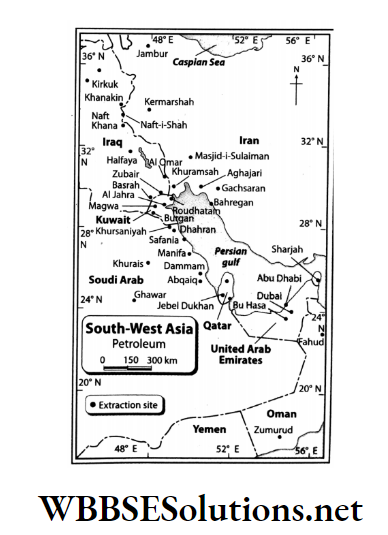
7. Oman: The noteworthy oilfield of Oman is-
- Natin.
8. Syria: The oilfields of Syria are-
- Omar
- Al-jab.

Question 2. Name the petroleum-producing countries of South-West Asia.
Answer:
The petroleum-producing countries of South-West Asia:
South-West Asia comprises of the world’s best petroleum-rich countries.
- The main petroleum producing countries are-Saudi Arabia,
- Iran,
- Kuwait,
- Qatar,
- United Arab Emirates,
- Oman,
- Bahrain,
- Iraq,
- Syria, etc.
Question 3. Write a short note on OPEC. Or, What is OPEC?
Answer:
OPEC:
The full form of OPEC is ‘The organisation of the Petroleum Exporting Countries’. OPEC was founded by 5 petroleum-producing countries in 1960. Its headquarter is located in Vienna (the capital of Austria). At present, the organisation has 13 members.
They are-
- Saudi Arabia
- Kuwait
- Iran
- United Arab Emirates
- The Republic of the Congo
- Libya
- Nigeria
- Algeria
- Angola
- Iraq
- Venezuela
- Gabon and
- Equatorial Guinea.
Its main objectives are-
- To coordinate and unify petroleum policies among member countries,
- To keep a regular, efficient and economic supply of petroleum to all-consuming nations,
- To secure a fair return on capital to those investing in the industry,
- To secure fair and stable prices for petroleum producers.
Question 4. Which regions are included in the petroleum production belt in Saudi Arabia?
Answer:
Regions are included in the petroleum production belt in Saudi Arabia:
The world’s second-largest petroleum-producing country is Saudi Arabia. The petroleum-producing regions in Saudi Arabia are located in the interior of the country and the continental shelf of its neighbouring Persian Gulf.
Out of these, the maximum production of petroleum comes from the eastern part i.e. the Hasa region. The onshore petroleum mining regions are-
- Ghawar
- Abqaiq
- Ain Dar
- Abu Hadriyah
- Khursani yah
- Dammam
- Qatif
- Dhahran, etc.
Among the offshore petroleum fields in the continental shelf region of the Persian Gulf,
- Safaniya,
- Abu Safah and
- Manifa are worth mentioning.
Question 5. Name the oil mines of Iran.
Answer:
Oil mines of Iran:
According to the latest data, Iran ranks fourth in the world in petroleum production. Most of the petroleum mines in Iran are located in the southwestern part of the country i.e. in the region of Khuzestan.
The centres of oil production are-
- Masjid-i-Sulaiman,
- Aghajari,
- Gachsaran,
- Haft Kol,
- Lali,
- Ahvaz,
- Naft Shahr (Naft-i-shah),
- Maidan-i-Naftun, etc.
Oil is also mined in the Qom or Qum region in Southern Tehran.
Question 6. What are the petroleum-producing regions of the United Arab Emirates?
Answer:
The petroleum-producing regions of the United Arab Emirates:
The world’s seventh-largest petroleum-producing country is the United Arab Emirates. Among the states in United Arab Emirates, Abu Dhabi and Sharjah are famous for petroleum production.
The important producing regions here are-
- Zakum,
- Asab,
- Murban,
- Bu Hasa,
- Huwaila,
- Amirshahi.
Question 7. Write a short note on Ghawar.
Answer:
Ghawar:
Ghawar is located in the eastern part of Saudi Arabia, a little away from the coasts of the Persian Gulf. The region is very important as-
- It is very rich in petroleum resources. The length of the petroleum field located here is more than 220 kilometres.
- This is the world’s largest petroleum mining area. Petroleum reserves in Ghawar are equal to the total petroleum reserves in the entire United States of America.
- The petroleum produced here is exported to different countries in Europe, North America and Asia.
- An average of 50 lakh barrels of petroleum is produced here every day.

Question 8. Write a short note on Safaniya.
Answer:
Safaniya:
Safaniya, located in the eastern part of Saudi Arabia is at a distance of 265 km north of Dhahran (located on the coast of the Persian Gulf). Safaniya is an important petroleum mine as-
- It is the largest offshore oil mine in the world.
- It has a reserve of about 37 billion barrels of petroleum and 5360 billion cubic feet of natural gas.
- The petroleum produced here is exported to different countries in Europe, North America and Asia.
- An average of 12 lakh barrels of petroleum is produced here every day.
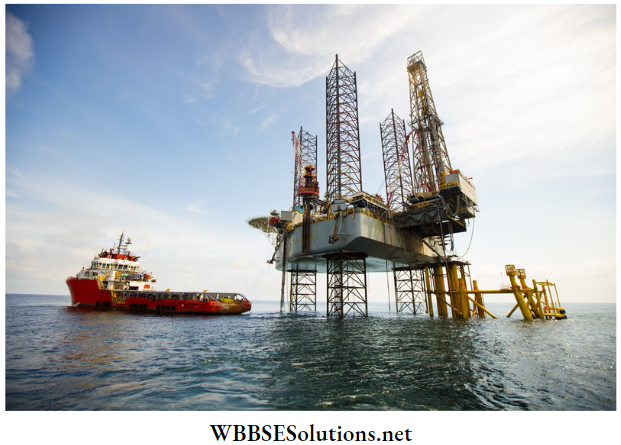
Question 9. Show the mountains radiating from the Armenian Knot.
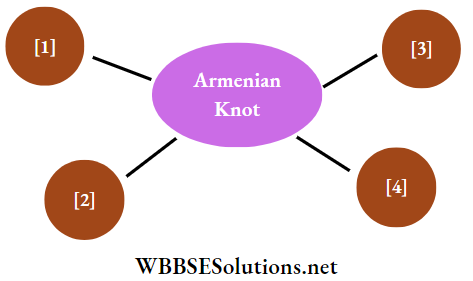
Answers:
1. Pontic
2. Taurus
3. Elburz
4. Zagros
Question 10. Show the mountains radiating from the Pamir Knot.
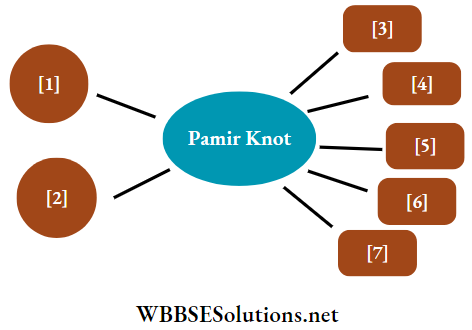
Answers:
1. Hindu Kush
2. Suleiman
3. Tien Shan
4. Altyn Tagh
5. Kunlun
6. Karakoram
7. Himalayas
Question 11.
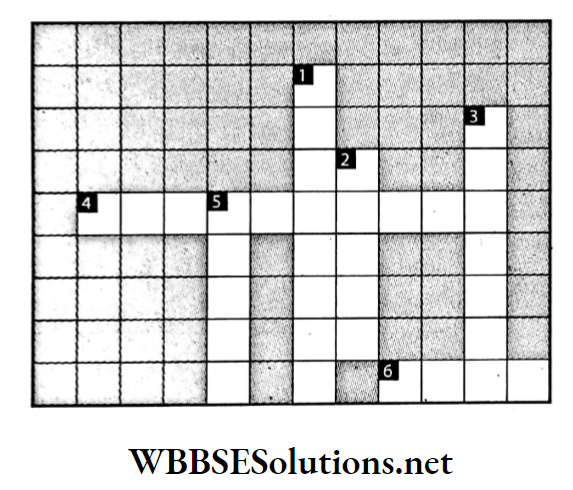
Down:
1. Highest mountain range in the world.
2. The Indus Valley Civilisation centred around this river.
3. Sorrow of China. 5. This plateau is known as the “Roof of the World”.
Across:
4. Largest lake in the world.
6. A junction of numerous mountain ranges.
Answers:
Down: 1. HIMALAYA, 2. INDUS, 3. HWANG HO, 5. PAMIR
Across: 4. CASPIAN SEA, 6. KNOT
Question 12.
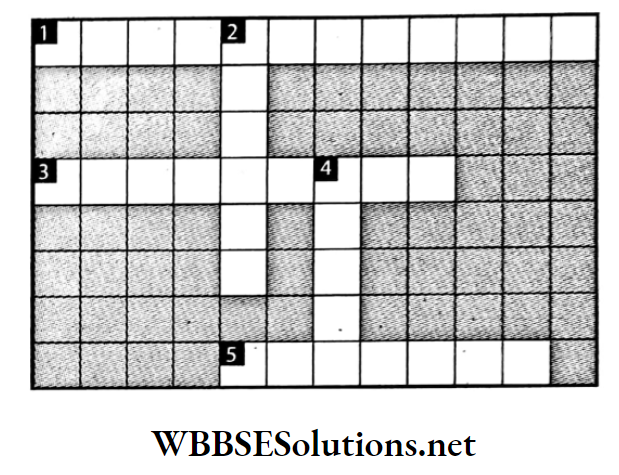
Down:
2. This river along with the Euphrates was the cradle of Mesopotamian Civilisation.
4. Largest coniferous forest in the world.
Across:
1. Longest river in Asia.
3. The longest river in southwest Asia.
5. Yellow River.
Answers:
Down: 2. TIGRIS, 4. TAIGA
Across: 1. YANGTZE KIANG 3. EUPHRATES 5. HWANG HO
Question 13. The climate of southwest Asian countries is very hot and dry. But, huge metropolitan cities have developed here. Compose a paragraph on how it has been possible.
Answer:
The development of huge metropolitan cities is the countries of south-west Asia:
- The climate of southwest Asian countries is very hot and dry. Vegetation is almost non-existent. Only deserts exist. Agricultural activity is almost non-existent in this region.
- In such a hostile environment, human settlement was very negligible. Petroleum reserves were discovered here in the beginning of the last century.
- After the discovery of huge reserves of petroleum, there has been a drastic change in the economy in this region. There is a huge reserve of oil in Saudi Arabia, Iran, Iraq, Kuwait, UAE, etc.
- Saudi Arabia alone contains 15.7% of the world’s crude oil reserves. There is a low demand of oil in this region due to the low population. That is why most of the mineral oil is exported abroad.
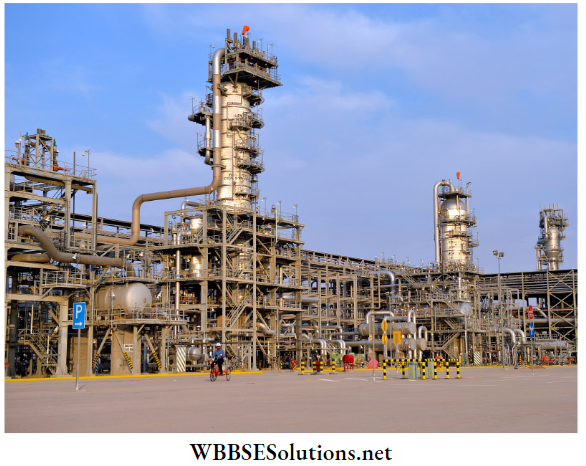
For this reason, the countries of southwest Asia earn a lot of money from trade. So, people here live a very luxurious life. As a result, Huge cities have sprung up in the vicinity of the oilfields.
WBBSE Chapter 9 Continent Of Asia Topic D Oil Field Of South West Asia Short Question And Answers
Question 1. What are the uses of petroleum?
Answer:
The various uses of petroleum in various sectors are-
- Industry: Petroleum is used as fuel and lubricant in industries.
- Transport: Petroleum by-products like diesel, petrol, and gasoline is used in all types of transport.
- Agriculture: Petroleum is indispensable in operating tractors, harvesters, reapers, and pump machines.
- Production of thermal electricity: Petroleum is used in the production of thermal electricity.
- Petrochemical industry: The petrochemical industry uses various by-products of petroleum.
- Household: Petroleum as a fuel is used in many household activities, such as cooking.
Question 2. Why is most of the oil produced in South-West Asia exported?
Answer:
Most of the oil produced in South-West Asia exported:
South-West Asia is not much densely populated. Thus, the demand for mineral oil in this region is not high. Thus, the maximum amount of the oil produced in this region is exported.
Question 3. Fill up the knowledge hive information on OPEC.
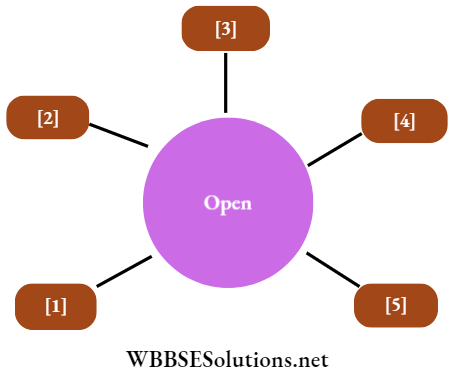
Answers:
1. OPEC was formed in September 1960.
2. At present OAPEC has 13 countries as its members.
3. These countries export about 77% of petroleum in the world.
4. The chief administrative centre of OPEC is situated in Vienna in Austria.
5. The organisation determines the price of petroleum in the world market.
Question 4. Which region is called the ‘Heart of Asia’ and why?
Answer:
The Central Highlands of Asia is called the ‘Heart of Asia’. The region is called so because of the following reasons-It constitutes 40% of the total area of Asia.
- It extends from the Mediterranean Coast in the west to the coastal plains of the East China Sea in the east and from the Himalayas in the south to Yablonoi and Stanovoy Mountains in the north.
- Most of the mountains and mountain ranges, and ancient plateaus of Asia originate from here.
- Most of the chief rivers of Asia originate from this region.
Question 5. “Continent of Asia: Cradle of Civilisation”-Explain.
Answer:
- Asia is one of the diverse continents with respect to races, religions, castes, cultures and livelihoods. Riverine civilisations had developed in this continent about 3500-5000 years before the birth of Christ.
- These include Harappa, Mohenjodaro and the Indus Valley Civilisation. The Mesopotamian civilisation along the Tigris and Euphrates rivers is also notable. The Hwang Ho River Valley was the foundation of Chinese Civilisation.
- Thus the continent of Asia is called the ‘cradle of civilisation’ or the birthplace of civilisation.
Question 6. State the importance of the South- west Asian countries in petroleum production.
Answer:
The importance of the South- west Asian countries in petroleum production:
- South-West Asia is the world’s largest petroleum-rich region. These countries have great importance in the global trade.
- The eight countries of southwest Asia constitute about 60% of the world’s total petroleum reserve and produce about 30% of the world’s total petroleum. As these countries have very less populations, their internal demand is also less.
- The primary member countries of the petroleum export trade controlling organisations i.e. OPEC and OAPEC are the South-West Asian countries.
WBBSE Chapter 9 Continent Of Asia Topic D Oil Field Of South West Asia Very Short Question And Answers
Question 1. Which is the second largest oil-producing country in the world?
Answer: Saudi Arabia.
Question 2. Give the abbreviation for the organization named ‘Organisation of the Petroleum Exporting Countries.
Answer: OPEC.
Question 3. What is the total number of members of OPEC at present?
Answer: 13.
Question 4. Where is the headquarter of OPEC situated?
Answer: Vienna, Austria.
Question 5. Which is the largest oilfield of Iraq?
Answer: Rumaila oilfield.
Question 6. Which is the world’s largest onshore oil mining region?
Answer: Ghawar.
Question 7. Which is the largest offshore oilfield in the world?
Answer: Safaniya oilfield.
Question 8. Which is the largest oil refinery in Iran?
Answer: Abadan Refinery.
Question 9. In which country of the middle east is the world’s largest oil refinery situated?
Answer: Kuwait.
Question 10. I am a large continental landmass formed by combining the landmasses of Europe and Asia. Who am I?
Answer: Eurasia
Question 11. I am a plateau located approximately in the middle of the continent of Asia. I am also known as ‘Roof of the World’. Who am I?
Answer: Pamir Plateau
Question 12. The Pontic, Taurus, Elburz, and Zagros Mountain Ranges have radiated from me. Who am I?
Answer: Armenian Knot
Question 13. I am a remnant of an ancient plateau lying across the Arabian Peninsula. Who am I?
Answer: Arabian Plateau
Question 14. I am the lowest place on Earth. I am also called the Salt Sea. Who am I?
Answer: Dead Sea
Question 15. Floods were frequent in China due to me. I am known as the ‘Sorrow of China’. Who am 1?
Answer: Hwang Ho River
Question 16. Heavy convectional rainfall occurs every afternoon in me. Which region am I?
Answer: Equatorial region
Question 17. I am the longest river in Asia and the third longest in the world. Who am I?
Answer: Yangtze Kiang
Question 18. I am the principal centre of the cotton textile industry in China. Who am I?
Answer: Shanghai
Question 20. My river basin has fertile soil and a large variety of crops are grown abundantly. I am the ‘Granary of China’. Who am I?
Answer: Middle Yangtze Basin
Question 21. I am known as the ‘Holland of China’. Who am I?
Answer: Yangtze Kiang River Delta
Question 22. I am the longest man-made canal in the world. I am situated in China. Who am I?
Answer: Grand Canal
Question 23. I am the capital of Japan. I am not only the largest city in Japan but also in the world in terms of population. Who am I?
Answer: Tokyo
Question 24. I have been selected as an ideal eco-friendly city by the Japanese Government. Who am I?
Answer: Yokohama
Question 25. I am the world’s largest onshore oil field, located on the Persian Gulf. Who am I?
Answer: Ghawar
Question 26. I am the world’s largest offshore oil field. Who am I?
Answer: Safaniya
Question 27. I was formed with 12 countries from South- west Asia. My role is to fix the price of petroleum and ascertain its supply in the world market. Who am I?
Answer: OPEC
WBBSE Chapter 9 Continent Of Asia Topic D Oil Field Of South West Asia Find The Odd One Out
Question 1. Indus civilisation Egyptian civilisation: Sumerian civilisation: Chinese civilisation
Answer: Egyptian civilisation (not a civilisation of Asia)
Question 2. Indian Ocean: Pacific Ocean: Arctic Ocean: Atlantic Ocean
Answer: Atlantic Ocean (not an ocean that bounds Asia)
Question 3. Arabian Plateau: Brazilian Plateau: Deccan Plateau Indo-China Plateau
Answer: Brazilian Plateau (not a plateau of Asia)
Question 4. Yangtze Kiang Si Kiang: Hwang Ho : Amu Darya
Answer: Amu Darya (not a river of China).
Question 5. Mahogany: Rosewood: Olive: Rubber
Answer: Olive (not a free of the equatorial climatic region)
Question 6. Tokyo: Yokohoma: Chiba : Shanghai
Answer: Shanghai (not a city of Japan)
Question 7. India Saudi Arabia: Iran Iraq
Answer: India (not a country of South- west Asia)
WBBSE Chapter 9 Continent Of Asia Topic D Oil Field Of South West Asia Correct The Following
Question 1. The largest forest in the world is the Selva forest.
Answer: Taiga
Question 2. Tibet is called the ‘Roof of the World’.
Answer: Pamir
Question 3. Lake Superior is the largest lake in the world.
Answer: Caspian Sea
Question 4. Pontic Mountain radiates from the Pamir Knot.
Answer: Armenian Knot
Question 5. Hwang Ho is the longest river in Asia.
Answer: Yangtze Kiang
Question 6. The climate of Singapore is of Mediterranean-type.
Answer: Equatorial
Question 7. Ichang province is called the ‘Granary of China.
Answer: Hunan
Question 8. Safaniya is the world’s largest oilfield.
Answer: Ghawar
WBBSE Chapter 9 Continent Of Asia Topic D Oil Field Of South West Asia Fill In The Blanks
Question 1. The headquarter of OPEC is located in ________.
Answer: Vienna
Question 2. The world’s second-largest oil-producing country is ________.
Answer: Saudi Arabia
Question 3. The world’s largest oil-producing centre is at ________ in Saudi Arabia.
Answer: Ghawar
Question 4. Lali oilfield is located in ________.
Answer: Iran
Question 5. The world’s largest onshore oil mine is at ________.
Answer: Ghawar
Question 6. The world’s largest offshore oilfield is at ________.
Answer: Safaniya
Question 7. Most of the oil mines of south-west Asia are located on the banks of the ________.
Answer: Persian Gulf
Question 8. The capital of Iraq is ________.
Answer: Baghdad
Question 9. The capital of Iraq is situated on the banks of river ________.
Answer: Tigris
Question 10. The first oil-producing centre in Saudi Arabia is ________.
Answer: Dammam
WBBSE Chapter 9 Continent Of Asia Topic D Oil Field Of South West Asia True Or False
Question 1. The world’s largest oil mine is Ghawar.
Answer: True
Question 2. The largest country by area in southwest Asia is Saudi Arabia.
Answer: True
Question 3. The largest petroleum-producing field in Iran is at Abadan.
Answer: False
Question 4 Basrah is an important petroleum-producing region in Iraq.
Answer: True
Question 5. The most petroleum-rich country of South- west Asia is Kuwait.
Answer: False
Question 6. The Persian Gulf and its coastal areas are the world’s largest source of oil.
Answer: True
Question 7. Ghawar in Saudi Arabia is the world’s largest offshore oilfield.
Answer: False
Question 8. Bahregan is an important oilfield in Iran.
Answer: True
Question 9. Abu Safah is an important offshore oilfield in Saudi Arabia.
Answer: True
Question 10. Al Ahmadi is the largest oil field in Iraq.
Answer: False
Question 11. 30% of the world’s total petroleum production comes from southwest Asia.
Answer: True
Question 12. OPEC control’s the price of petroleum in the of river world market.
Answer: True
WBBSE Chapter 9 Continent Of Asia Topic D Oil Field Of South West Asia Scrambled Words
1. HOANGHW
2. UNKUNL
3. AISHGHAN
4. MAHAYOKO
5. YASANIFA
6. UIKOKSH
7. BIGO
8. DAARYAMU
9. ATAIG
Answers:
1. HWANG HO
2. KUNLUN
3. SHANGHAI
4. YOKOHAMA
5. SAFANIYA
6. SHIKOKU
7. GOBI
8. AMU DARYA
9. TAIGA
WBBSE Chapter 9 Continent Of Asia Topic D Oil Field Of South West Asia Match The Columns
Question 1.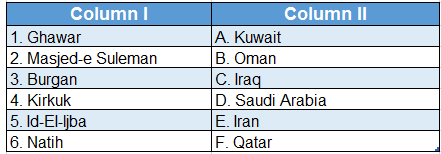
Answer: 1. D, 2. E, 3. A, 4. C, 5. F, 6. B
